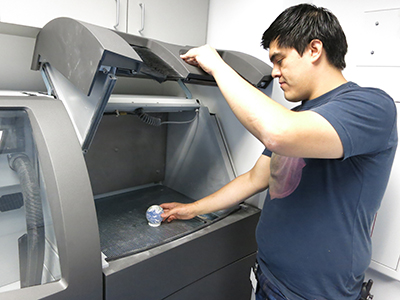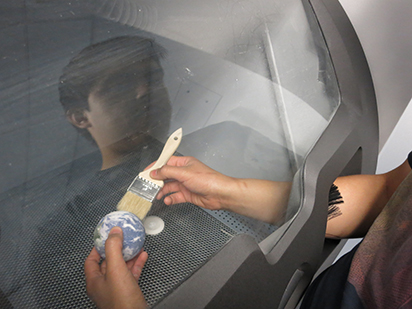by Greg Richards, OIT Data Center Operations Staff
Rice University’s new 3D printer, managed through the Shared Equipment Authority (SEA), will help students and faculty further their learning and research. The 3D Systems ProJet 660 Pro is housed and operated in Rice’s Primary Data Center (PDC) by OIT’s Data Center Operations staff under the guidance of Dr. George Phillips, Professor of Biochemistry and Cell Biology as well as Professor of Chemistry. Currently, Dr. Phillips and OIT staff members such as Eron Montes are testing the general use of the machine and how best to utilize its functionality. Various models have been produced, including an orc character from a video game and a magnified replica of the Hantavirus. The models are vibrant and colorful, with very clear details and a solid feel to them.
The extra dimensions –think height, depth, and weight– of the 3D models mean the printing process can be time consuming, ranging up to 10 hours for one job. Depending on the complexity and height of the file, the printer produces around one vertical inch per hour. After Dr. Phillips or one of his graduate students create and submit a 3D image, Eron supervises the process that converts an electronic image to a file type the printer can use. The image is then positioned inside the virtual printing deck. Printing multiple models in the same deck can reduce waste. Positioned correctly, a black and white chessboard, a green and brown orc, a red and silver Corvette, and a neon-colored virus model can all be printed in the same deck. Multiple images can be printed at once as long as they fit within the printing area, and the models may even be stacked atop each other to better utilize the space.
Out of Thin Air
Once the images are virtually arranged inside the deck, the job is sent and the printing process begins. Layer by layer, the printer’s nozzles fire black, white or colored compounds onto the printing deck. A binding material is applied with every pass, gluing sand-like compounds together in specific areas while leaving adjoining spaces unbound. The models may seem to take shape, literally, out of thin air. At the completion of this stage, a 3D model of bound agents will be left standing inside a deck that also contains non-solidified materials which must be brushed, blown, and vacuumed away to reveal the actual printed objects. This cleaning process takes place in a chamber within the 3D printer, to collect and recycle unbound materials for future use. A sealant is applied to the free-standing models, followed by a few hours of drying. Finally, the process is complete and the model can be retrieved.
The effects of gravity continue to challenge the 3D printing process for certain types of models. In particular, fragile models of proteins and molecules may have trouble supporting their own weight. Even with careful handling, parts of the models may snap; one possible solution under consideration is the use of supports, possibly printing a separate stand underneath the fragile printouts to help strengthen or cradle them during the post-print stages. Currently the 3D printer is being used solely by Dr. Phillips and his graduate students as they test the 3D printer in its pilot program. The program is planning to be open to others in the future. Access and logistics parameters are still being explored, including who should have access to the printer, what is the best way to submit a job, and how completed models will be delivered when finished.




